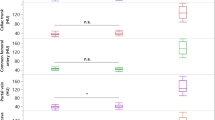Abstract
The purpose of the study was to evaluate in which phase of the cardiac cycle visualization of the cardiac veins could achieve the highest possible quality. In 138 patients (aged 56.6 ± 10.6; 58F) with a suspicion of CAD, a 64-slice CT (Toshiba Aquilion) was performed. In each case ten 3D volume rendering reconstructions were created from 0 to 90% R–R intervals (step 10%) using a 0.5 mm slice thickness (reconstructions 2.0 mm). An arbitrary score of the quality of images was introduced. In 82 (59.4%) patients optimal image quality was noted at the 40% phase, in 28 (20.3%) at the 30% phase and finally in 14 (10.1%) at the 50% phase. These 3 phases (30/40/50%) were the best option for 124 (89.8% of all) patients. In the rest of the patients the best visualization was obtained in other phases as follows: 60 and 80% for 4 patients (2.9%); 70% for 3 patients (2.3%) and at the 0, 10, 20% one patient at each phase (0.7%). The optimal phases of the cardiac cycle for the visualization of the cardiac venous system are 30 or 40%. Less frequently, an alternative could be the 50% phase.


Similar content being viewed by others
References
Martinek M, Nesser HJ, Aichinger J et al (2006) Accuracy of integration of multislice computed tomography imaging into three-dimensional electroanatomic mapping for real-time guided radiofrequency ablation of left atrial fibrillation-influence of heart rhythm and radiofrequency lesions. J Interv Card Electrophysiol 17:85–92
Kistler PM, Earley MJ, Harris S et al (2006) Validation of three-dimensional cardiac image integration: use of integrated CT image into electroanatomic mapping system to perform catheter ablation of atrial fibrillation. J Cardiovasc Electrophysiol 17:341–348
Hill AJ, Ahlberg SE, Wilkoff BL et al (2006) Dynamic obstruction to coronary sinus access: the Thebesian valve. Heart Rhythm 3:1240–1241
Karaca M, Bilge O, Dinckal MH et al (2005) The anatomic barriers in the coronary sinus: implications for clinical procedures. J Interv Card Electrophysiol 14:89–94
Mlynarski R, Sosnowski M, Wlodyka A et al (2009) A user-friendly method of cardiac venous system visualization in 64-slice computed tomography. Pacing Clin Electrophysiol 32:323–329
Meisel E, Pfeiffer D, Engelmann L et al (2001) Investigation of coronary venous anatomy by retrograde venography in patients with malignant ventricular tachycardia. Circulation 104:442–447
Vaseghi M, Cesario DA, Ji S, Shannon KM et al (2005) Beyond coronary sinus angiography: the value of coronary arteriography and identification of the pericardiophrenic vein during left ventricular lead placement. Pacing Clin Electrophysiol 28:185–190
Blendea D, Mansour M, Shah RV et al (2007) Usefulness of high-speed rotational coronary venous angiography during cardiac resynchronization therapy. Am J Cardiol 100:1561–1565
Van de Veire NR, Schuijf JD, De Sutter J et al (2006) Non-invasive visualization of the cardiac venous system in coronary artery disease patients using 64-slice computed tomography. J Am Coll Cardiol 48:1832–1838
Tada H, Kurosaki K, Naito S et al (2005) Three-dimensional visualization of the coronary venous system using multidetector row computed tomography. Circ J 69:165–170
Hendel RC, Patel MR, Kramer CM et al (2006) ACCF/ACR/SCCT/SCMR/ASNC/NASCI/SCAI/SIR 2006 appropriateness criteria for cardiac computed tomography and cardiac magnetic resonance imaging. J Am Coll Cardiol 48:1475–1497
Muhlenbruch G, Koos R, Wildberger JE et al (2005) Imaging of the cardiac venous system: comparison of MDCT and conventional angiography. Am J Roentgenol 185:1252–1257
Abbara S, Cury RC, Nieman K et al (2005) Noninvasive evaluation of cardiac veins with 16-MDCT angiography. Am J Roentgenol 185:1001–1006
Dewey M, Teige F, Rutsch W et al (2008) CT coronary angiography: influence of different cardiac reconstruction intervals on image quality and diagnostic accuracy. Eur J Radiol 67:92–99
Scharf SM, Bromberger-Barnea B, Permutt S (1971) Distribution of coronary venous flow. J Appl Physiol 30:657–662
Schoenhagen P (2008) Back to the future: coronary CT angiography using prospective ECG triggering. Eur Heart J 29:153–154
Einstein AJ, Henzlova MJ, Rajagopalan S (2007) Estimating risk of cancer associated with radiation exposure from 64-slice computed tomography coronary angiography. JAMA 298:317–323
Hounsfield GN (1980) Computed medical imaging. Science 210:22–28
Piccini JP, Hernandez AF, Dai D et al (2008) Use of cardiac resynchronization therapy in patients hospitalized with heart failure. Circulation 118:926–933
Author information
Authors and Affiliations
Corresponding author
Rights and permissions
About this article
Cite this article
Mlynarski, R., Sosnowski, M., Wlodyka, A. et al. Optimal image reconstruction intervals for noninvasive visualization of the cardiac venous system with a 64-slice computed tomography. Int J Cardiovasc Imaging 25, 635–641 (2009). https://doi.org/10.1007/s10554-009-9463-0
Received:
Accepted:
Published:
Issue Date:
DOI: https://doi.org/10.1007/s10554-009-9463-0




